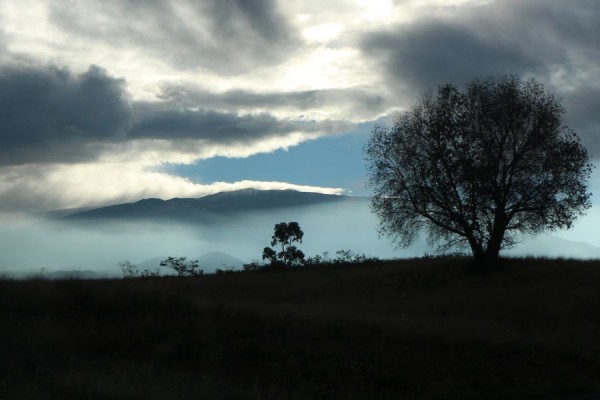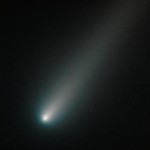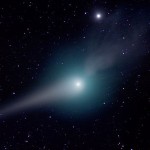
Tag: C/2012 S1
Watching for ISON with Cloudcam
Wondering what comet C/2012 S1 ISON is looking like today? There is a very good camera aimed at the eastern horizon from the summit of Mauna Kea. Just what you need to take a look for yourself.
The CFHT Cloudcam is a DSLR camera that is programmed to take exposures constantly through the night. Used by the telescope operators to monitor oncoming weather, the camera shows the sky conditions over the eastern coast of the island and the city of Hilo. The images are live during the night, each morning you can load a timelapse video of the entire night.
The camera has quite a following, quite a few people check the camera constantly. This includes quite a few UFO consipracists. If anything odd shows up on the camera the video quickly shows up on YouTube and linked to postings on the UFO sites. When the launch of a missile from Vandenberg AFB in California created a glowing sphere of light these websites went into overdrive with wild speculation.
Most of the mornings this week have been too cloudy to see the comet. I have been checking the video each day. Currently at magnitude 5 the comet will be a small dot in the imagery. As the comet brightens it should appear nicely in Cloudcam.

Comet C/2012 S1 ISON
Dispatch from the Summit – A Cloudy Mountian
Comet ISON is sinking rapidly into the dawn. I have been waiting for a chance to photograph it for a couple weeks now. The gear is ready to go. Any morning that I have had available has been awash with clouds. Not strictly my problem, Keck has lost quite a few nights to weather over the same time period.
Tonight looks to be no exception. We have a number of engineering tests planned for Keck 1, including the first night on sky for a system many of us have put a lot of work into, the TRICK infrared tip-tilt detector for Keck 1 AO. It does not look good.
Update: The night was a complete loss, the telescope never opened.

Comet? Where?
There is one question we all have to ask when a beautiful comet graces the skies…

Like any other solar system object, comets move against the sky. Even worse, when close to the Earth or Sun they can be moving so quickly against the stars that coordinates quickly become out of date. Aiming a telescope using coordinates a day old, or sometimes even only an hour old will result in a view of empty sky. A few stars perhaps, but no comet.
You need a table of coordinated calculated for regular time intervals, an ephemeris. Alternately you need a set of coordinates calculated for the exact time you will be looking.
Preparing for Comet C/2012 S1 ISON
Astronomers, professional and amateur alike, are getting ready for comet C/2012 S1 ISON, possibly the highlight of a year that has already seen several good comets.
Discovered in September 2012 by Vitali Nevski and Artyom Novichonok, of the ISON project, a group of telescopes dedicated to discovering and tracking solar system objects. The comet was then an 18th magnitude object in the outer solar system, an impressive find for a small telescope.

The next surprise was hinted at by the orbital calculations. The orbital solution indicated a nearly hyperbolic path, suggesting that this was a new comet, one that had not visited the inner solar system before. This possibility was strengthened by later observations of the comet.
ISON Webcast
We put it together in very short notice. Fortunately a webcast is pretty easy to put together.
Keck is hosting a sizable team of folks who are here to observe comet ISON. Astronomers from several institutions are participating in the NASA Comet ISON Observing Campaign. They have a total of 6½ nights, but only the last few hours of each night as the comet rises in the dawn. Comet C/2012 S1 ISON is starting to encounter significant publicity, we may as well take advantage of this.
It was a lot of fun. I particularly like the spot (41:00) where I made the mistake of saying spectra were not very pretty to look at in a room full of spectroscopists. These folks love spectra and quickly corrected me, leading to a nice discussion on why spectra are so valuable to astronomy, often more valuable than photos.
The video is embedded below. A lot of good information about comet ISON, indeed about comets in general. Nothing like having a room full of comet experts…
Waiting for ISON
I will probably make my first attempt to photograph C/2012 S1 ISON this coming weekend. A couple reasons for waiting… The bright Moon will have moved out of the morning sky by then. The comet, currently around magnitude ten, is brightening rapidly.
On the other hand the comet is plunging towards the Sun, rising later each day. Wait much longer and the photographic opportunity will slip away, at least until after Thanksgiving, when the comet will again appear after perihelion.
In the meantime, one of my favorite comet photos from years past…

The Portents of ISON
Comets have long been regarded as omens of extraordinary portent. Novae, eclipses, conjunctions, anything seen in the sky can serve in this role, but bright comets have always held a special awe.

Bright comets are invariably seen as omens by some. History is littered with stories of comets and prophesies. This has not changed, there are many recent examples… Hale-Bopp, Hyakutake, Elenin, each has been used to make all manner of wild predictions. Comet C/2012 S1 ISON certainly fits the role. It will most likely be quite bright, easily visible without optical aid. It may even be visible in the daytime.
Comet C/2012 S1 ISON
A new comet discovered earlier this week has caught the attention of the astronomy community. Comet C/2012 S1 (ISON) was discovered Tuesday by a telescope affiliated with ISON, the International Scientific Optical Observation Network. This is a network of mid-sized telescopes dedicated to surveillance of the near earth region of our solar system.
The reason this comet is intriguing is a combination of a large estimated size and an orbit that appears to provide both a close approach to the Sun and favorable viewing from the Earth.
The comet will approach the sun as close as 0.012 AU on November 28th, 2013, quite close indeed. The comet will also approach Earth as close as 0.4 AU (60 million kilometers or 37 million miles) on December 26th, 2013. As a result this comet could achieve a magnitude well into the negative numbers, brighter than most objects in the sky except the Sun or Moon.
This comet is in addition to comet C/2011 L4 (PanSTARRS), expected to be an unaided eye comet during the spring of 2013. If we get lucky 2013 will be a great year for comets.
As I have cautioned in the past, comet predictions are to be taken with a good amount of skepticism. This could be a spectacular comet, or this could be a mediocre comet, we will just have to wait and see. In the meantime pay attention to the light curve as it nears the Sun. As my friend David Levy observed… “Comets are like cats; they have tails, and they do precisely what they want.”

